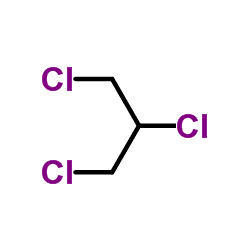Abbreviations TCP | ||
 | ||
Appearance colorless or straw yellow transparent liquid | ||
1,2,3-Trichloropropane (TCP) is a chemical compound that was an impurity in 1,3-dichloropropene fumigants manufactured by Shell Chemical Company and Dow Chemical Company. Exposure by inhalation, skin contact, or ingestion can be harmful to health.
Contents
Production

1,2,3-Trichloropropane can be produced via the chlorination of propylene. Other reported methods for producing 1,2,3-trichloropropane include the addition of chlorine to allyl chloride, reaction of thionyl chloride with glycerol, and the reaction of phosphorus pentachloride with either 1,3- or 2,3-dichloropropanol. TCP also may be produced as a byproduct of processes primarily used to produce chemicals such as dichloropropene (a soil fumigant), propylene chlorohydrin, propylene oxide, dichlorohydrin, and glycerol.
Uses

Historically, TCP has been used as a paint or varnish remover, a cleaning and degreasing agent, and was an impurity in certain pesticides. It is also used as a chemical intermediate in the process of making chemicals, such as hexafluoropropylene and polysulfides, and as an industrial solvent.

1,2,3-TCP had purportedly been used in the past as a solvent for paint and varnish removal, as a cleaning and degreasing agent, and as a cleaning and maintenance solvent. No current information is available to indicate that it continues to be used for these purposes.

Pre-1980s, agricultural use of chloropropane-containing soil fumigants for use as pesticides and nematicides was prevalent in the United States. Some soil fumigants, which contained a mixture of primarily 1,3-dichloropropene and 1,2-dichloropropane, and in which 1,2,3-TCP was a minor component, e.g., trade name of D-D, were marketed for the cultivation of various crops including citrus fruits, pineapples, soy beans, cotton, tomatoes,and potatoes. D-D was first marketed in 1943, but is no longer available in the United States, and has been replaced with Telone II, which was first available in 1956. Telone II reportedly contains as much as 99 percent 1,3-dichloropropene and up to 0.17 percent by weight 1,2,3-TCP (Zebarth et al., 1998). Before 1978, approximately 55 million pounds/year of 1,3-dichloropropene were produced annually in the United States, and approximately 20 million pounds/year of 1,2-dichloropropane and 1,2,3-TCP were produced as by-products in the production of 1,3-dichloropropene. Over 2 million pounds of pesticides containing 1,3-dichloropropene were used in California alone in 1978. Telone II is still used for vegetables, field crops, fruit and nut trees, grapes, nursery crops, and cotton.

Another documented use of 1,2,3-TCP was as a “branching” or curing agent in polysulfide polymers (Kirk Othmer Chemical Encyclopedia, 2001). Polysulfide polymers have been used as the “standard sealant for virtually all aircraft fuel tanks and bodies” since the 1950s. Also, “one of the first large-scale applications of the liquid polysulfides was as a binder for rocket fuel,” from 1946 until 1958. Summary tables published by Kirk Othmer (2001) list the properties of a number of Morton Thiokol LP series of polysulfide polymer-based sealers, with concentrations of the branching agent (1,2,3-TCP) ranging from 0.5 to 2.0 percent. Liquid polysulfide polymers are used mainly as sealants in manufacturing applications, including applications related to double-paned windows, boat hulls and decks, printing rolls, integral aircraft fuel tanks, and aircraft bodies.
By the early 1980s, approximately 95 percent of chloropropanes were being used as chemical intermediates. Chemical intermediates are industrial chemicals that are used as the starting point to produce other chemicals. 1,2,3-TCP is currently used as an intermediate in the production of polysulfone liquid polymers, the synthesis of hexafluoropropylene, and as a cross-linking agent in the synthesis of polysulfides. Polysulfone liquid polymers are used in the following industries: aerospace, automotive,consumer goods, electrical and electronic, health care, and in industrial equipment, such as compressor and pump valve components. Hexafluoropropylene is a fluorointermediate that is a key building block required to produce Teflon fluoropolymers; it has applications in the agrochemical, electronics, dyes/pigments, pharmaceutical, and specialty polymermarkets. Polysulfides are used as catalyst sulfidation agents and in the formulation of lubricant additives created for use in high-pressure environments or applications.
1,2,3-TCP is manufactured as a stand-alone product in the United States. It also is produced in significant quantities as an unwanted by-product of the production of other chlorinated compounds such as epichlorohydrin, and is used internally by manufacturers as an intermediate in the production of other chemicals such as polysulfone and epoxy resins.
Effects of exposure
Humans can be exposed to TCP by inhaling its fumes or through skin contact and ingestion. TCP is recognized in California as a human carcinogen, and extensive animal studies have shown that it causes cancer. Short term exposure to TCP can cause throat and eye irritation and can affect muscle coordination and concentration. Long term exposure can affect body weight and kidney function.
Proposed federal regulation
As of 2013 TCP was not regulated as a contaminant by the federal government, but research shows that it could have severe health effects; only the state of California had significant regulation of this compound.
In a drinking water project proposed by the United States Environmental Protection Agency (EPA), TCP was one of sixteen suspected human carcinogens being considered for regulation in 2011.
State regulation
The California Department of Public Health (CDPH) established a non-enforceable Notification Level of 5 ng/L (parts per trillion) and the Office of Environmental Health Hazard Assessment established a Public Health Goal (PHG) of 0.7 ng/L. CDPH is working to establish legally enforceable Maximum Contaminant Level (MCL) which is set as close to the PHG as is technically and economically feasible. The state of Alaska has promulgated standards establishing cleanup levels for 1,2,3-trichloropropane contamination in soils and groundwater. The state of California considers 1,2,3-trichloropropane to be an unregulated contaminant that should be monitored. The state of Colorado has also promulgated a groundwater standard although there is no drinking water standard. Although there is not much regulation on this substance, it has proved that TCP is a carcinogen in laboratory mice, and most likely a human carcinogen as well. On a federal scale, there is no MCL for this contaminant. The Permissible Exposure Limit (PEL) in occupational setting for air is 50 ppm or 300 mg/m3. The concentration in air at which TCP becomes an Immediate Danger to Life and Health (IDLH) is at 100 ppm. These regulations were reviewed in 2009.
TCP as an emerging contaminant
TCP does not contaminate soil. Instead, it leaks down into groundwater and settles at the bottom of the reservoir because TCP is more dense than water. This makes TCP in its pure form a DNAPL (Dense Nonaqueous Phase Liquid) and it is, therefore, harder to remove it from groundwater. There is no evidence that TCP can naturally decompose, but it might in favorable conditions. Groundwater remediation of TCP can occur through in situ chemical oxidation, permeable reactive barriers, and other remediation techniques. Several TCP remediation strategies have been studied and/or applied with varying degrees of success. These include extraction with granular activated carbon, in situ chemical oxidation, and in situ chemical reduction. Recent studies suggest that reduction with zerovalent metals, particularly zerovalent zinc, may be particularly effective in TCP remediation. Bioremediation may also be a promising clean-up technique.
